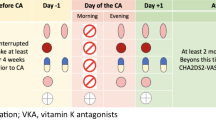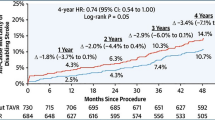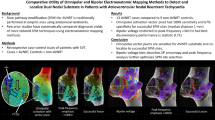Abstract
Background
There is a lack of compelling data regarding the benefit of percutaneous ventricular assist devices (PVAD) in patients undergoing ventricular tachycardia (VT) ablation. The study aims to conduct a meta-analysis comparing the safety and efficacy of PVAD versus no-PVAD (N-PVAD) during VT ablation.
Methods
Studies meeting criteria were systematically reviewed. Baseline characteristics and clinical outcomes were extracted and analyzed. A meta-analysis was performed using random-effects model to calculate risk ratio (RR) and mean difference (MD) with 95% confidence interval (CI).
Results
The meta-analysis included five retrospective, observational studies consisting of 2026 patients (PVAD group—284 patients versus N-PVAD group—1742 patients). The PVAD group was sicker with significantly higher VT storm, lower LVEF and greater proportion of NYHA class ≥ III than N-PVAD (p < 0.050). The acute procedural success [RR 0.95, 95% CI, (0.89–1.00), p = 0.070], VT recurrence [RR 0.94, 95% CI, (0.66–1.34), p = 0.740] and mortality [RR 1.28, 95% CI, (0.43–3.83), p = 0.660] were similar on follow-up between PVAD versus N-PVAD. PVAD group also had significantly higher complications [RR 1.83, 95% CI (1.21–2.76), p = 0.004] and longer fluoroscopy [MD + 7.31 min, 95% CI (0.91–13.71), p = 0.030] and procedure time [MD + 71.41 min, 95% CI (31.67–111.14), p < 0.001] than N-PVAD.
Conclusion
Patients receiving PVAD support during VT ablation were sicker with no significant difference in acute procedural success, VT recurrence, and mortality compared with N-PVAD. PVAD support was also associated with higher complications and longer fluoroscopy and procedure time. A prospective randomized controlled trial will identify if using PVAD support in unstable patients undergoing VT ablation will impact clinical outcomes.




Similar content being viewed by others
References
Reddy VY, Reynolds MR, Neuzil P, Richardson AW, Taborsky M, Jongnarangsin K, et al. Prophylactic catheter ablation for the prevention of defibrillator therapy. N Engl J Med. 2007;357:2657–65.
Kuck KH, Schaumann A, Eckardt L, et al. Catheter ablation of stable ventricular tachycardia before defibrillator implantation in patients with coronary heart disease (VTACH): a multicentre randomised controlled trial. Lancet (London, England). 2010;375:31–40.
Sapp JL, Wells GA, Parkash R, Stevenson WG, Blier L, Sarrazin JF, et al. Ventricular tachycardia ablation versus escalation of antiarrhythmic drugs. N Engl J Med. 2016;375:111–21.
Tung R, Vaseghi M, Frankel DS, Vergara P, di Biase L, Nagashima K, et al. Freedom from recurrent ventricular tachycardia after catheter ablation is associated with improved survival in patients with structural heart disease: an international VT ablation center collaborative group study. Heart Rhythm. 2015;12:1997–2007.
Knight BP, Jacobson JT. Assessing patients for catheter ablation during hospitalization for acute heart failure. Heart Fail Rev. 2011;16:467–76.
Carbucicchio C, Santamaria M, Trevisi N, Maccabelli G, Giraldi F, Fassini G, et al. Catheter ablation for the treatment of electrical storm in patients with implantable cardioverter-defibrillators: short- and long-term outcomes in a prospective single-center study. Circulation. 2008;117:462–9.
Di Biase L, Burkhardt JD, Lakkireddy D, et al. Ablation of stable VTs versus substrate ablation in ischemic cardiomyopathy: the VISTA randomized multicenter trial. J Am Coll Cardiol. 2015;66:2872–82.
Fernandez-Armenta J, Penela D, Acosta J, et al. Substrate modification or ventricular tachycardia induction, mapping, and ablation as the first step? A randomized study. Heart Rhythm. 2016;13:1589–95.
Kusa S, Miller MA, Whang W, Enomoto Y, Panizo JG, Iwasawa J, et al. Outcomes of ventricular tachycardia ablation using percutaneous left ventricular assist devices. Circ Arrhythm Electrophysiol. 2017;10(6). https://doi.org/10.1161/CIRCEP.116.004717.
Aryana A, Gearoid O’Neill P, Gregory D, et al. Procedural and clinical outcomes after catheter ablation of unstable ventricular tachycardia supported by a percutaneous left ventricular assist device. Heart Rhythm. 2014;11:1122–30.
Mathuria N, Wu G, Rojas-Delgado F, Shuraih M, Razavi M, Civitello A, et al. Outcomes of pre-emptive and rescue use of percutaneous left ventricular assist device in patients with structural heart disease undergoing catheter ablation of ventricular tachycardia. J Interv Card Electrophysiol. 2017;48:27–34.
Bunch TJ, Darby A, May HT, Ragosta M, Lim DS, Taylor AM, et al. Efficacy and safety of ventricular tachycardia ablation with mechanical circulatory support compared with substrate-based ablation techniques. Europace. 2012;14:709–14.
Miller MA, Dukkipati SR, Chinitz JS, Koruth JS, Mittnacht AJ, Napolitano C, et al. Percutaneous hemodynamic support with Impella 2.5 during scar-related ventricular tachycardia ablation (PERMIT 1). Circ Arrhythm Electrophysiol. 2013;6:151–9.
Miller MA, Dukkipati SR, Mittnacht AJ, Chinitz JS, Belliveau L, Koruth JS, et al. Activation and entrainment mapping of hemodynamically unstable ventricular tachycardia using a percutaneous left ventricular assist device. J Am Coll Cardiol. 2011;58:1363–71.
Turagam MK, Vuddanda V, Atkins D et al. Hemodynamic support in ventricular tachycardia ablation. An International VT Ablation Center Collaborative Group Study. JACC Clin Electrophysiol. 2017;3(13):1534–43.
DerSimonian R, Laird N. Meta-analysis in clinical trials. Control Clin Trials. 1986;7:177–88.
Higgins JP, Altman DG, Gotzsche PC, et al. The Cochrane Collaboration’s tool for assessing risk of bias in randomised trials. BMJ (Clinical research ed). 2011;343:d5928.
Santangeli P, Muser D, Zado ES, Magnani S, Khetpal S, Hutchinson MD, et al. Acute hemodynamic decompensation during catheter ablation of scar-related ventricular tachycardia: incidence, predictors, and impact on mortality. Circ Arrhythm Electrophysiol. 2015;8:68–75.
Reddy YM, Chinitz L, Mansour M, Bunch TJ, Mahapatra S, Swarup V, et al. Percutaneous left ventricular assist devices in ventricular tachycardia ablation: multicenter experience. Circ Arrhythm Electrophysiol. 2014;7:244–50.
Aryana A, d'Avila A, Cool CL, Miller MA, Garcia FC, Supple GE, et al. Outcomes of catheter ablation of ventricular tachycardia with mechanical hemodynamic support: an analysis of the Medicare database. J Cardiovasc Electrophysiol. 2017;28:1295–302.
Naidu SS. Novel percutaneous cardiac assist devices: the science of and indications for hemodynamic support. Circulation. 2011;123:533–43.
Rihal CS, Naidu SS, Givertz MM, et al. 2015 SCAI/ACC/HFSA/STS clinical expert consensus statement on the use of percutaneous mechanical circulatory support devices in cardiovascular care: endorsed by the American Heart Assocation, the Cardiological Society of India, and Sociedad Latino Americana de Cardiologia Intervencion; Affirmation of Value by the Canadian Association of Interventional Cardiology-Association Canadienne de Cardiologie d’intervention. J Am Coll Cardiol. 2015;65:e7–e26.
Miller MA, Dukkipati SR, Koruth JS, d'Avila A, Reddy VY. How to perform ventricular tachycardia ablation with a percutaneous left ventricular assist device. Heart Rhythm. 2012;9:1168–76.
Nakahara S, Tung R, Ramirez RJ, Michowitz Y, Vaseghi M, Buch E, et al. Characterization of the arrhythmogenic substrate in ischemic and nonischemic cardiomyopathy implications for catheter ablation of hemodynamically unstable ventricular tachycardia. J Am Coll Cardiol. 2010;55:2355–65.
Kumar S, Baldinger SH, Romero J, et al. Substrate-based ablation versus ablation guided by activation and entrainment mapping for ventricular tachycardia: a systematic review and meta-analysis. J Cardiovasc Electrophysiol. 2016;27:1437–47.
Author information
Authors and Affiliations
Corresponding author
Ethics declarations
Conflict of interest
The authors declare that they have no conflict of interest.
Electronic supplementary material
ESM 1
(DOCX 30 kb)
Rights and permissions
About this article
Cite this article
Turagam, M.K., Vuddanda, V., Koerber, S. et al. Percutaneous ventricular assist device in ventricular tachycardia ablation: a systematic review and meta-analysis. J Interv Card Electrophysiol 55, 197–205 (2019). https://doi.org/10.1007/s10840-018-0477-1
Received:
Accepted:
Published:
Issue Date:
DOI: https://doi.org/10.1007/s10840-018-0477-1




